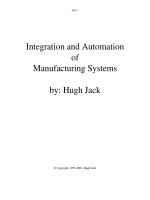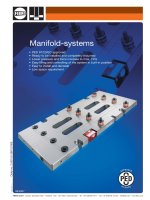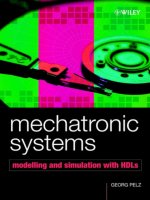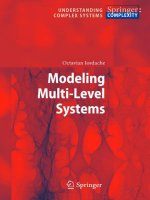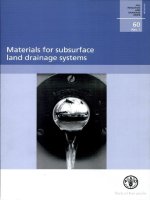Modeling Multi-Level Systems pdf
Bạn đang xem bản rút gọn của tài liệu. Xem và tải ngay bản đầy đủ của tài liệu tại đây (1.78 MB, 251 trang )
Springer Complexity
Springer Complexity is an interdisciplinary program publishing the best research and academic-level
teaching on both fundamental and applied aspects of complex systems - cutting across all traditional
disciplines of the natural and life sciences, engineering, economics, medicine, neuroscience, social and
computer science.
Complex Systems are systems that comprise many interacting parts with the ability to generate a new
quality of macroscopic collective behavior the manifestations of which are the spontaneous formation
of distinctive temporal, spatial or functional structures. Models of such systems can be successfully
mapped onto quite diverse “real-life" situations like the climate, the coherent emission of light from lasers,
chemical reaction-diffusion systems, biological cellular networks, the dynamics of stock markets and of
the internet, earthquake statistics and prediction, freeway traffic, the human brain, or the formation of
opinions in social systems, to name just some of the popular applications.
Although their scope and methodologies overlap somewhat, one can distinguish the following main
concepts and tools: self-organization, nonlinear dynamics, synergetics, turbulence, dynamical systems,
catastrophes, instabilities, stochastic processes, chaos, graphs and networks, cellular automata, adaptive
systems, genetic algorithms and computational intelligence.
The two major book publication platforms of the Springer Complexity program are the monograph
series “Understanding Complex Systems" focusing on the various applications of complexity, and the
“Springer Series in Synergetics", which is devoted to the quantitative theoretical and methodological
foundations. In addition to the books in these two core series, the program also incorporates individual
titles ranging from textbooks to major reference works.
Editorial and Programme Advisory Board
Dan Braha
New England Complex Systems, Institute and University of Massachusetts, Dartmouth
Péter Érdi
Center for Complex Systems Studies, Kalamazoo College, USA and Hungarian Academy of
Sciences, Budapest, Hungary
Karl Friston
Institute of Cognitive Neuroscience, University College London, London, UK
Hermann Haken
Center of Synergetics, University of Stuttgart, Stuttgart, Germany
Viktor Jirsa
Centre National de la Recherche Scientifique (CNRS), Université de la Méditerranée, Marseille, France
Janusz Kacprzyk
System Research, Polish Academy of Sciences, Warsaw, Poland
Scott Kelso
Center for Complex Systems and Brain Sciences, Florida Atlantic University, Boca Raton, USA
Markus Kirkilionis
Mathematics Institute and Centre for Complex Systems, University of Warwick, Coventry, UK
Jürgen Kurths
Potsdam Institute for Climate Impact Research (PIK), Potsdam, Germany
Linda Reichl
Center for Complex Quantum Systems, University of Texas, Austin, USA
Peter Schuster
Theoretical Chemistry and Structural Biology, University of Vienna, Vienna, Austria
Frank Schweitzer
System Design, ETH Zürich, Zürich, Switzerland
Didier Sornette
Entrepreneurial Risk, ETH Zürich, Zürich, Switzerland
Understanding Complex Systems
Founding Editor: J.A. Scott Kelso
Future scientific and technological developments in many fields will necessarily depend upon coming
to grips with complex systems. Such systems are complex in both their composition - typically many
different kinds of components interacting simultaneously and nonlinearly with each other and their environments on multiple levels - and in the rich diversity of behavior of which they are capable.
The Springer Series in Understanding Complex Systems series (UCS) promotes new strategies and
paradigms for understanding and realizing applications of complex systems research in a wide variety of
fields and endeavors. UCS is explicitly transdisciplinary. It has three main goals: First, to elaborate the
concepts, methods and tools of complex systems at all levels of description and in all scientific fields,
especially newly emerging areas within the life, social, behavioral, economic, neuroand cognitive sciences (and derivatives thereof); second, to encourage novel applications of these ideas in various fields
of engineering and computation such as robotics, nano-technology and informatics; third, to provide a
single forum within which commonalities and differences in the workings of complex systems may be
discerned, hence leading to deeper insight and understanding.
UCS will publish monographs, lecture notes and selected edited contributions aimed at communicating new findings to a large multidisciplinary audience.
Octavian Iordache
Modeling Multi-Level
Systems
ABC
Author
Dr. Octavian Iordache
Polystochastic
Pitfield blvd. St. Laurent 3205
H4S 1H3 Montreal
Canada
E-mail:
ISBN 978-3-642-17945-7
e-ISBN 978-3-642-17946-4
DOI 10.1007/978-3-642-17946-4
Understanding Complex Systems
ISSN 1860-0832
Library of Congress Control Number: 2011921006
c 2011 Springer-Verlag Berlin Heidelberg
This work is subject to copyright. All rights are reserved, whether the whole or part of the material is concerned, specifically the rights of translation, reprinting, reuse of illustrations, recitation,
broadcasting, reproduction on microfilm or in any other way, and storage in data banks. Duplication of this publication or parts thereof is permitted only under the provisions of the German
Copyright Law of September 9, 1965, in its current version, and permission for use must always
be obtained from Springer. Violations are liable to prosecution under the German Copyright Law.
The use of general descriptive names, registered names, trademarks, etc. in this publication does
not imply, even in the absence of a specific statement, that such names are exempt from the relevant
protective laws and regulations and therefore free for general use.
Typeset & Cover Design: Scientific Publishing Services Pvt. Ltd., Chennai, India.
Printed on acid-free paper
987654321
springer.com
…his way was to carry his mind into his laboratory, and literally to make of his
alembics and cucurbits instruments of thought…
C. S. Peirce
The Fixation of Belief, 1877
Preface
Modeling multi-level complex systems is the object of this book.
Complex systems are assemblies of several subsystems and are characterized
by emergent behavior resulting by nonlinear interactions among subsystems for
multiple levels of organization.
The complexity of numerous systems is rooted in the existence of many levels
of self-organization corresponding to different time and space scales.
There is a need to provide general frameworks able to combine several scales
and reality levels of the complex systems in one coherent and transdisciplinary
discourse. A challenge for complex systems science and technology is to develop
mathematical formalisms and modeling methods able to capture complete systems
dynamics by integration of contribution at several hierarchically organized levels.
Existing models involve a large number of nonlinear equations, difficult to handle
analytically or numerically, and to correlate with real systems behavior. Among
the open questions, we mention the definition of relevant parameters and variables
to be measured at each scale or level, the study of coupling between different
levels, the insufficiency of the algorithmic schema for evolvable or autonomous
systems modeling.
The proposed modeling tools for multi-scale and multi-level systems are the
polystochastic models, PSM. These characterize systems coming out when several
stochastic processes, running at different conditioning levels, are capable to
interact with each other, resulting in qualitatively new processes and systems.
Polystochastic models aim to discover and describe new structures and
behaviors, which cannot be detected by one level approaches and cannot be
reduced to the summation of several levels contributions.
The book is divided in 12 chapters. The chapters 1 to 4 delineate the problems
and the methods. The role of multiple levels of reality for different concepts and
theories of complexity is highlighted in the first chapter of the book. The relation
between levels of reality and categories is emphasized.
Several mathematical methods that have been used in PSM development are
briefly presented in chapter 2. This refers to “random systems”, “non-Archimedean
analysis”, and “category theory”. Specific concepts as categorification and
integrative closure are introduced. Categorical formulation of integrative closure
offers the general PSM framework which serves as a flexible guideline for the large
variety of research and multi-level modeling problems presented in the book.
Chapter 3 introduces the conventional real-field frame for PSM and some
illustrative examples. Chapter 4 leads into the new PSM methodologies. The
model categorification method is illustrated. The need of appropriate notions of
time and probabilities and of new theoretical concepts is emphasized.
VIII
Preface
The chapters 5 to 8 are dedicated to case studies relevant to the sciences of
nature.
For this part the levels are usually associated to time scales. Chapters 5 and 6
elaborate PSM for mixing and transport in single or multi-compartmental systems
while chapter 7 contains a multi-scale study of dispersion and turbulence. Major
applications for these chapters range from chemical engineering to pharmacology
and environment.
Chapter 8 highlights entropy and entropy production roles for integrative
closure conceptual framework. Application concerns entropy production for
multi-scale biosystems. Based on different types of causation, new informationl
entropy criteria are proposed.
The next four chapters, 9 to 12, outline the potential of the proposed multi-level
modeling methods for the domain of system sciences. For this part the levels are
conceptual knowledge levels or reality levels associated to categories. Chapter 9
establishes the contact of PSM with formal concept analysis. Applications include
enumeration of separation flow-sheets, pharmacology, security management for
information technology, and failure analysis. Diagrammatic reasoning using
existential graphs is presented in chapter 10. The correlations with pragmatism
and studies of continuity are emphasized.
Chapter 11 applied evolvable designs of experiments to pharmaceutical
pipeline for drug discovery and development, to reliability management systems
and failure analysis for printed circuits.
The connection of the presented PSM methodology with some forward-looking
research directions for autonomous systems has been outlined by Chapter 12.
Delineated case studies refer to autonomous experimentation, case based
reasoning, beliefs desires intentions agents, organic and autonomic computing,
autonomous animats, viable systems modeling, and multi-level modeling for
informational systems.
Necessary elements of non-Archimedean functional analysis and category
theory are presented in appendices.
The case studies analyzed in the book, represent a source of inspiration for
emerging technologies in their current transition from adaptive toward evolvable
and autonomous systems. They joint also recent trends advocating the convergence
of disciplines and the need for transdisciplinary research for complexity. The
multi-level modeling is in place at the intersection of sciences of matter as
chemistry, life sciences, cognitive sciences, engineering and mathematics.
The PSM methodology presented and developed in this book is successfully
confronted with an exciting field of major practical interest and a key area for
future investigations, the multi-level complexity.
Contents
Contents
1 Introduction ......................................................................................................1
1.1 Multi-level Systems ...................................................................................1
1.1.1 Levels and Complexity ..................................................................1
1.1.2 Related Concepts and Theories ......................................................3
1.2 Levels of Reality and Categories ...............................................................6
References .........................................................................................................9
2 Methodological Resources..............................................................................11
2.1 Random Systems .....................................................................................11
2.2 Non-Archimedean Analysis.....................................................................13
2.3 Categorical Frames ..................................................................................14
2.3.1 Introducing Category Theory ........................................................14
2.3.2 Higher Dimensional Categories ....................................................16
2.3.3 Models Categorification................................................................18
2.3.4 Synthetic Differential Geometry ...................................................19
2.4 Closure.....................................................................................................21
2.4.1 Semantic Closure ..........................................................................21
2.4.2 Two Levels Modeling ...................................................................22
2.4.3 Integrative Closure ........................................................................24
References .......................................................................................................31
3 Conventional PSM Frames ............................................................................35
3.1 One Conditioning Level Frame ...............................................................35
3.2 Multiple Conditioning Levels..................................................................38
3.3 Illustrative Case Studies ..........................................................................41
3.3.1 Mixing in Turbulent Flow.............................................................41
3.3.2 Diffusion on a Hierarchical Space.................................................44
3.3.3 Different Views for the Same Phenomenon..................................48
References .......................................................................................................51
4 New PSM Frames ...........................................................................................53
4.1 General Frameworks for PSM .................................................................53
4.1.1 Basic Categorical Frameworks.....................................................53
4.1.2 Multiple Levels ............................................................................55
4.2 Time Frames ............................................................................................61
4.2.1 The Problem of Time Frame ........................................................61
4.2.2 Frame of Infinitesimals ................................................................62
4.3 Probabilities and Possibilities ..................................................................63
X
Contents
4.3.1 Frame of Infinitesimals for Probabilities and Possibilities...........63
4.3.2 Non Well Founded Sets and Probabilities....................................65
4.4 Models Categorification Methodology ....................................................66
4.4.1 Frame of Infinitesimals for PSM..................................................66
4.4.2 NA Difference Equation ..............................................................68
References .......................................................................................................69
5 Mixing in Chemical Reactors ........................................................................71
5.1 Discrete Model of Imperfect Mixing .......................................................71
5.1.1 Residence Time Distribution, RTD ..............................................71
5.1.2 Discrete Model for Residence Time Distributions .......................75
5.1.3 Local Anesthetic Effects...............................................................80
5.1.4 Stochastic Features. Real Field Probabilities................................81
5.1.5 PSM Frame for Discrete Model....................................................83
5.1.6 Comparison with Theory ..............................................................84
5.2 Continuous Model of Imperfect Mixing ..................................................85
5.2.1 The Continuous Model .................................................................85
5.2.2 PSM Frame for Continuous Model...............................................89
5.2.3 Comparison with Theory ..............................................................90
5.2.4 SDG Solution for Imperfect Mixing .............................................93
References .......................................................................................................94
6 Compartmental Systems ................................................................................95
6.1 Compartmental Models ...........................................................................95
6.2 Discrete Models for a Series of Imperfectly Mixed Vessels....................97
6.3 Continuous Time Model ..........................................................................99
6.3.1 Residence Time Distributions .......................................................99
6.3.2 Interaction of Chemical Compound with Membranes ................103
References .....................................................................................................105
7 Turbulent Mixing .........................................................................................107
7.1 Dispersion..............................................................................................107
7.1.1 The Dispersion Equation.............................................................107
7.1.2 The Frame of Infinitesimals ........................................................109
7.1.3 Hydrological Experiments ..........................................................113
7.1.4 SDG Solution for Dispersion ......................................................115
7.1.5 Convection Model.......................................................................117
7.2 Intermittency by Vortex Line Stretching ...............................................118
7.2.1 Conventional Frame ....................................................................118
7.2.2 Multi-level Frame .......................................................................120
References .....................................................................................................123
8 Entropy..........................................................................................................125
8.1 Background............................................................................................125
8.2 Informational Entropy ...........................................................................127
8.3 Entropy Production for Biosystems .......................................................129
Contents
XI
8.4 Entropy and Integrative Closure ............................................................135
8.5 Cooperative Model for Nerve Excitation...............................................138
References .....................................................................................................141
9 Formal Concept Analysis .............................................................................143
9.1 Galois Lattices .......................................................................................143
9.2 Separation Lattice ..................................................................................144
9.3 Drugs Mixture........................................................................................148
9.4 Failure Analysis .....................................................................................149
9.5 Triadic Context Analysis .......................................................................151
9.6 Rough Set Approximations....................................................................153
9.7 Hierarchical Class Analysis ...................................................................156
9.8 Tetradic Context Analysis .....................................................................158
9.9 Security Management Architectures......................................................160
References .....................................................................................................162
10 Existential Graphs ......................................................................................165
10.1 Systems of Existential Graphs .............................................................165
10.2 Continuum and Existential Graphs ......................................................170
10.3 Separation Flow Sheets........................................................................173
References .....................................................................................................176
11 Evolvable Designs of Experiments ............................................................179
11.1 Pharmaceutical Pipeline.......................................................................179
11.2 Designs of Experiments for Drug Discovery.......................................182
11.3 Drugs Development .............................................................................184
11.3.1 General PSM Framework for Discovery and Development....184
11.3.2 Informational Tools.................................................................185
11.3.3 Anesthetics Mixtures...............................................................187
11.3.4 Acylthiocarbamates Library Design........................................190
11.4 Reliability Management System ..........................................................193
References .....................................................................................................196
12 Autonomous Systems Perspective .............................................................199
12.1 Autonomous Experimentation .............................................................199
12.2 Case Based Reasoning Systems...........................................................200
12.3 Belief Desire Intention Agents ............................................................203
12.4 Autonomic and Organic Computing....................................................205
12.5 Autonomous Animats ..........................................................................207
12.6 Viable Systems Models .......................................................................208
12.7 Meta-modeling Architectures ..............................................................209
References .....................................................................................................211
Appendices ........................................................................................................213
Appendix 1: Non-Archimedean Analysis…………………………………………213
A1.1 Valued Fields…………...………………………………………………..213
A1.2 Normed Linear Spaces and Orthogonality………..……………………..214
References………………………………............................................................217
XII
Contents
Appendix 2 Category Theory ...........................................................................218
A2.1 Category Theory .......................................................................................218
A2.2 The n-Categories.......................................................................................219
A2.3 Periodic Table...........................................................................................220
A2.4 Categorification and Coherence................................................................222
A2.5 Toposes Modeling SDG............................................................................225
References ...........................................................................................................226
Index ...................................................................................................................229
List of Figures
2.1 Multiple scales networks and n-graphs......................................................... 17
2.2 Semantic closure........................................................................................... 22
2.3 Two-level models ......................................................................................... 23
2.4 Integrative closure network .......................................................................... 24
2.5 Integrative closure network with sub-levels ................................................. 25
2.6 Integrative closure for categories.................................................................. 26
2.7 Integrative closure for categories and sub-categories ................................... 26
2.8 Integrative closure for centered categories ................................................... 29
2.9 Cybersemiotic star and integrative closure ................................................... 30
2.10 Tetradic sign ................................................................................................ 30
3.1 RSCC model ................................................................................................. 36
3.2 Continuous time RSCC model...................................................................... 38
3.3 Example of PSM frame ................................................................................ 41
3.4 Mixing process ............................................................................................. 42
3.5 One level of states......................................................................................... 44
3.6 Energy barriers ............................................................................................. 45
3.7 PSM frame for one level of states................................................................. 46
3.8 Multi-levels of states..................................................................................... 46
3.9 PSM frame for multiple levels of states........................................................ 47
3.10 States at different levels............................................................................... 48
3.11 RSCC associated to one level conditional stochastic chain ......................... 49
3.12 PSM frame associated to multiple levels conditional stochastic chain ........ 50
4.1
4.2
4.3
4.4
4.5
4.6
4.7
4.8
Two levels framework .................................................................................. 54
Three levels hierarchical framework ............................................................ 55
Three realms network ................................................................................... 56
Four levels hierarchical framework .............................................................. 57
Four realms network ..................................................................................... 57
Fully integrated four realms network............................................................ 59
Centered four realms network....................................................................... 60
Cycle of cognition......................................................................................... 60
5.1 Imperfect mixing .......................................................................................... 75
5.2 Discrete time scales and integrative closure for one cell .............................. 79
5.3 Continuous time scales and integrative closure for one cell ......................... 91
XIV
List of Figures
6.1 Cellular model .............................................................................................. 97
6.2 Cellular models with imperfect mixing ........................................................ 98
6.3 Time scales and integrative closure for multiple cells ................................ 103
7.1 Scales and integrative closure..................................................................... 115
7.2 Intermittency by vortex line stretching ....................................................... 120
7.3 Two time scales intermittency .................................................................... 121
8.1 Entropy production for multi-scale systems ............................................... 134
8.2 Integrative closure for multi-scale entropy production............................... 136
8.3 Integrative closure and entropy principles .................................................. 137
9.1 Galois lattice for separation-four properties ............................................... 147
9.2 Galois lattice for separation-reduced labeling ............................................ 147
9.3 Procaine ...................................................................................................... 148
9.4 Galois lattice for composed drugs .............................................................. 149
9.5 Galois lattice for failure analysis ................................................................ 151
9.6 Trillatice for triadic power set context........................................................ 153
9.7 Galois lattice for separation-five properties................................................ 154
9.8 Oriented formal contexts ............................................................................ 155
9.9 Hierarchical structure of classes for dyadic context ................................... 157
9.10 Triadic classes hierarchy study ................................................................. 158
9.11 Tetralattice for tetradic power set context................................................. 159
9.12 Integrative closure for tetradic lattice ....................................................... 160
9.13 Four realms network for security of information systems ........................ 161
9.14 Four realms network for failure diagnosis ................................................ 161
9.15 Four realms network for security management......................................... 162
10.1 Sep: A is false or separated....................................................................... 166
10.2 Subgraphs ................................................................................................. 166
10.3 Double seps............................................................................................... 167
10.4 Nested levels of subgraphs ....................................................................... 167
10.5 Double seps rule of equivalence ............................................................... 168
10.6 Insertion and erasure................................................................................. 168
10.7 Iteration/Deiteration.................................................................................. 169
10.8 Broken seps............................................................................................... 170
10.9 Integrative closure for existential graphs .................................................. 172
10.10 Monoidal flow-sheets ............................................................................. 174
10.11 Monoidal flow-sheets: tree like form...................................................... 174
10.12 Braided flow-sheets ................................................................................ 175
10.13 Parity cube flow-sheets........................................................................... 176
11.1
11.2
11.3
11.4
Pharmaceutical pipeline............................................................................ 180
Pharmaceutical pipecycles........................................................................ 181
EDOE basic framework ............................................................................ 183
Framework for drug discovery and development ..................................... 185
List of Figures
XV
11.5 Acylthiocarbamates structure ................................................................... 191
11.6 Framework for reliability management system ........................................ 194
11.7 Integrative closure for EDOE ................................................................... 196
12.1 Architecture for autonomous experimentation ......................................... 200
12.2 CBR basic framework............................................................................... 201
12.3 Centered frameworks for evolvable CBR................................................. 203
12.4 Structure of BDI agents ............................................................................ 204
12.5 Centered frameworks for evolvable BDI architecture .............................. 205
12.6 Automatic computing architecture............................................................ 206
12.7 Organic computing architecture................................................................ 207
12.8 Architecture for autonomous animats ....................................................... 208
12.9 Architecture for viable systems ................................................................ 209
12.10 Centered meta-meta-modeling frameworks............................................ 210
A2.1 Pentagon relations.................................................................................... 223
A2.2 Hexagon relations .................................................................................... 224
A2.3 Parity cube relations................................................................................. 224
List of Tables
5.1 Action potential amplitude for the anesthetic effect ..................................... 80
5.2 Objective function for single compartment model ....................................... 80
5.3 RTD functions predicted by different models............................................... 92
6.1 Compartmental models ................................................................................. 96
6.2 Relative height of the compound action potential ...................................... 104
6.3 Objective function for multi-compartments model..................................... 104
9.1 Input information-isomers properties ......................................................... 145
9.2 Formal context: components and properties ............................................... 145
9.3 Formal context for separations-four properties........................................... 146
9.4 Properties of drugs...................................................................................... 148
9.5 Plating voids type for different processing steps ........................................ 150
9.6 Triadic power set context............................................................................ 152
9.7 Formal context for separations-five properties ........................................... 154
9.8 Dyadic formal context ................................................................................ 156
9.9 Triadic context ............................................................................................ 157
9.10 Tetradic power set context (partial data) .................................................. 159
11.1
11.2
11.3
11.4
11.5
11.6
11.7
11.8
Greco-Latin square design ........................................................................ 184
Topical anesthetics.................................................................................... 188
Informational entropies for mixtures ........................................................ 189
Reference set for acylthiocarbamates-radicals.......................................... 191
Reference set for acylthiocarbamates-matrix............................................ 191
Informational entropies for Acylthiocarbamates ...................................... 192
Latin square design ................................................................................... 194
Resistance patterns. Classification table ................................................... 195
A2.1 Periodic table of categories...................................................................... 221
A2.2 Correspondence between sets and categories .......................................... 222
Abbreviations
CT-category theory
EDOE-evolvable design of experiment
EG-existential graphs
FCA-formal concept analysis
GL-Galois lattice
NA-non-Archimedean
NBIC-nano-bio-info-cogno
PSM-polystochastic model
RS-random systems
RSCC-random systems with complete connections
RTD-residence time distribution
SDG-synthetic differential geometry
SKUP-states, conditions, operators, possibilities
Chapter 1
Introduction
Abstract. A major property of complex systems is their self-structuring in
multiple conditioning levels with different spatial and temporal scales.
Multi-scale and multi-level aspects for modern theories and concepts as:
dissipative structures, auto-catalytic systems, catastrophes, synergetics, fractals,
artificial life, complex adaptive systems, cybernetics, and biomimetic computation
are revealed here.
The topic of multi-level structure of reality and its relation to the study of
categories is discussed with emphasize on ontology and pragmatism.
1.1 Multi-level Systems
1.1.1 Levels and Complexity
A complex system is described as a structure or a process involving non-linear
interactions among many parts and levels, which displays emergent properties.
This means that the aggregate system activity is not derivable from the linear
summation of the activity of individual components and that novel structure,
patterns or properties arise, from interactions among parts.
A survey of the literature indicates that there is no standard definition of a
complex or emergent system. However features such as hierarchy of levels,
timescales, emergence, unpredictability, interconnectivity, self-organization, selfsimilarity, collective behavior, evolvability are focused in complexity studies
(Adami 2002, Bar-Yam 1999, Kauffman S. 1995, Mainzer 1996).
Complexity is supposed to come from non-linearity and from a large number of
elements with many degrees of freedom and many relationships.
A key property of complex systems is their self-structuring in conditioning
levels, each of more or less homogeneous characterization.
Spatial and temporal scales may be associated to conditioning levels.
Self-organization will occur when individual independent parts in a complex
system interact in a jointly cooperative manner that is also individually
appropriate, such as to generate a new level organization.
2
1 Introduction
Complex systems can be studied at different levels of investigation. For
example we can study an industrial installation at the level of molecules or at the
level of devices interactions. The number of observation levels is finite. The
understanding of complexity changes with the domains of application. Some
surveys consider that the complexity level has not an absolute meaning, and it is
only a relative notion depending on the level of observation or abstraction. These
surveys emphasize a facet of complexity as a relative concept which depends both
on the task at hand and on the tools available to achieve this task.
For environmental, industrial or pharmacological systems, despite the fact that
numerous physical or chemical processes are identified as complex, more of the
conventional ones may be operated in regimes were multi-level complexity
properties are neglected. For several centuries, physical and chemical sciences
made great steps by experimenting and constructing simplified single level models
of complex phenomena, deriving properties from the models, and verifying those
properties by new experiments. This approach worked because the multi-level
complexities ignored in that models were not the essential properties of the
phenomena. It does not work when the multi-level complexity becomes the
essential characteristic. In an increasing number of cases the multi-level
complexity is not transient or atypical, but it is an intrinsic property of that
systems.
Several examples will clarify these aspects of complexity.
Consider the moisture dispersion in soil, a first example inspired from
environmental studies. Taking into account only particle movements in the interparticle space of macro pores, simple stochastic process of moisture dispersion
will result. This model corresponds to the one level approach. More detailed
studies should be concerned about different levels of the real moisture transport
process, after macro pores, successive scales of micro pores, restrictions for flow,
and so on. In more developed environmental studies a two-state conditional
process valued on the set {“wet”, “dry”}, should be taken into account on daily
and on seasonal scale. The basic physical phenomenon, the moisture migration in
soil, arrive to be perceived now as a multi-level complex phenomenon in which
many interacting processes, at different levels of organization, evolve in a
randomly changing environment. The evolvable multi-scale fluid dispersion
ecosystem, self-adapting, self-creating the internal and external restrictions, is the
object of the PSM studies.
The next example we will consider is the problem of modeling in industrial
multi-scale systems (Fraga et al. 2006). Modeling frameworks should incorporate
evolvability in order to selectively manipulate the models and to incorporate
details and complexity only in those areas of the models which are critical to
provide an adequate solution and remove such details and complexity were it is
not. Thus we can imagine a multi-level modeling and simulation capability within
which the following hold:
• A model consists of a hierarchy of layers or scales of increasing detail,
complexity and sophistication, spanning the entire set of length and time scales
from molecules to business chains
1.1 Multi-level Systems
3
• Each layer or scale contains a model definition and a number of parameters
• Each layer accepts parameters from below and calculates the parameters
required by the layer above
• Evolvability capabilities such as ontology, languages and agents, may be
incorporated at any point to define and modify the models, parameters and
solutions
Such multi-level architecture should have a number of capabilities as for instance:
• Should be flexible and extensible
• Should provide a rational and consistent basis for multi-scale models
• Should incorporate external modules, models, codes and be integrated with
laboratory and plant systems
• Should allow to the user to indicate fitness for purpose
• Should ensure systems evolvability and autonomy in an environment changing
at an ever-increasing rate
As another example we will consider the drug action in pharmacological systems.
The pharmacology seeks to develop a global understanding of the interactions
between individual physiology and drug action. To develop such an understanding
it is necessary to analyze interactions across and between various scales of
organization.
The organisms should be analyzed at the levels of organs, tissues, cells or
molecules. Drugs are prescribed at the organism level but exert their effect by
interacting with their target at the molecular level.
As observed from these illustrative examples, the complexity of systems arises
not only from the number of its components or levels but rather from the way
these components are interconnected.
Non-linear interactions between different levels and scales represent a
characteristic of complexity. Complex systems differ basically from complicated
ones. Systems may outline complexity on both structural and on functional level.
Structural complexity increases with the number of interacting subunits, the
mutual connectedness among them and the degree of interactions of individual
subunits. On a functional level, complexity increases with the minimum length of
the algorithm from which one can retrieve the full behavior of the system.
Complexity in computing science accommodates a hierarchy of conditioning
levels depending on the computational time for computer programs or algorithms.
The conditioning levels are determined by the structure as well as the degree of
coherent cooperativeness among similar modules of the complex system.
1.1.2 Related Concepts and Theories
Since a universally accepted theory of multi-level complexity does not exists, a
brief comparison with related theories sharing similar objectives with PSM, and
allowing the study of multi-level systems would be of interest.
Prigogine (1980, 1989) and his group (“Brussels School”) have shown that
systems far from equilibrium are able to self-organize in a hierarchical way, in
4
1 Introduction
several levels. The equations of dynamics or of thermodynamics are nonlinear and
drive to bifurcations. Non-linearity proves to be necessary but not sufficient for
complexity. The emergence of hierarchical levels appears to be one of the
possibilities. The complex system organizes itself by jumping from an equilibrium
state with few hierarchical levels to another equilibrium state with more levels. By
this process the system gets more complex. The resulting structures stable in space
and time are called “dissipative structures” (Nicolis and Prigogine 1989). Bénard’s
cells and oscillating chemical reactions have been studied as examples of selforganizing processes.
In relation with the above theory, Eigen and Schuster (1979) focused on the
origin of life, the domain where chemical self-organization in levels and biological
evolution met. The developed concepts were that of “hypercycle”, an autocatalytic cycle of chemical reactions containing other cycles, and of
“quasispecies”, the fuzzy distribution of genotypes characterizing a population of
quickly mutating organisms or molecules.
In the theory of so-called “catastrophes”, Thom studied the mathematics of
abrupt jumps from a stable steady state to another stable steady state when a
control parameter is varying (Thom 1975). For a critical value of the control
parameter, the complex system spontaneously jumps from one equilibrium state to
another. The process of self-organization by emergence of new levels can be seen
as a hierarchical catastrophe by which a system jumps into more and more
hierarchical states. For critical values of control parameters, when a new
configuration with new levels appears, the system will select it by stochastic
mechanisms Catastrophe theory proposes classifications of the critical behavior of
continuous mappings.
Haken (1983) has studied the processes of self-organization by “synergy”, that
is by cooperative actions of parts of a system. Results concerning the stability of
systems with a large number of degrees of freedom corresponding to different
levels associated to timescales and concerning the replacing of fast varying
variable by time averages have been pointed in “synergetics” theory. Old
structures become unstable and break down by changing control parameters. On
the microscopic level the stable modes of the old states are dominated by unstable
modes. The main principle in synergetics is the “enslavement principle”. Due to
small differences in initial conditions caused by natural fluctuations, one mode
will become the master and enslaves all other modes. As a consequence, just a few
order parameters are sufficient to describe the complex system. This seems to be
the case in the presented here approach were one basic level induce the convergent
behavior of the first, second and third levels.
In the last decades the term “fractal” coined by Mandelbrot (1982) was
extensively used to describe the class of objects and phenomena, which display
scale-invariance and self-similarity for different levels. Fractal identifies structures
in which increasing magnification reveals increasing detail and the newly revealed
structure looks the same as what one can observe at lower magnification. It was
supposed that many structures and features in nature appear as fragmented and
manifest properties of scaling and self-similarity. Notable examples are trees and
dendrites, humidity pictures, clouds in a solution, amorphous and porous
1.1 Multi-level Systems
5
materials, branched polymers, diffusion-limited aggregates, percolation clusters,
and glasses.
General features of the multi-level organized complex stochastic systems with
memory have been revealed for “self-organizing systems” theory (Kauffman S.
1995), “stochastic automata” theory ,“cellular automata” (Wolfram 1994), in
“genetic algorithms” theory (Holland 1996), in “artificial neural network” theory
(Carpenter and Grossberg 1987) for adaptive resonance theory, in “artificial life”
theory (Langton 1989, 1990), in “complex adaptive systems”, “second order
cybernetics” (von Foerster 1981) , “autopoiesis” theories (Maturana and Varela
1992), and so on. Multi-level aspects of some of the above enumerated concepts
and theories will be briefly presented in what follows.
Kauffman S., (1995) has studied how networks of mutually activating or
inhibiting genes can give rise to the differentiation of organs and tissues during
embryological development. This led to investigate the properties of multi-level
Boolean networks of different sizes and degrees of connectedness. The genetic
algorithms introduced by Holland (1996) are parallel, computational
representations of the processes of variation, recombination and selection on the
basis of fitness that underlay most processes of evolution and adaptation. They
have been applied to general problem solving, control and optimization tasks,
inductive learning and the modeling of ecological systems.
The “artificial life” approach, tries to develop technological systems such as
computer programs and autonomous robots that exhibit life-like properties as for
instance, reproduction, swarming, and co-evolution. Based on cellular automata
studies, and investigations of self-organized criticality, Langton (1989, 1990) has
proposed the general thesis that complex systems emerge and maintain on the
edge of chaos, the narrow domain between frozen constancy and chaotic
turbulence. The "edge of chaos" idea is a step towards a general definition of
multi-level complexity.
Though it shares its subject, the general properties of complex systems across
traditional disciplinary boundaries, with cybernetics and systems theory, the
theory of “complex adaptive systems” is distinguished by the extensive use of
computer simulations as a research tool, and an emphasis on less organized
systems, such as ecologies or markets. The "second-order cybernetics” is a theory
developed to describe the observed and observing systems (von Foerster 1981).
The emphasis on circular, self-referential processes has been continued in
Maturana and Varela work on autopoietic systems. The “autopoiesis” that is the
self-production denotes the fact that complex systems produce their own
components. In that sense they are autonomous or "organizationally closed". For
them the environment is merely a source of perturbations that need to be
compensated in order to maintain the system's organization (Maturana and Varela
1992).
The “general systems theory” and the study of complex systems in various
fields of human sciences testify the wide variety of hierarchical organizations
(Klir 1985, Salthe 1985, Ahl and Allen 1996). It is generally accepted that there is
a hierarchy of complexity in nature with more or less highly developed levels of
organization. A self-organization realizing the most effects with a restricted
6
1 Introduction
number of different parts was considered as the best one. One of the characteristic
of the living environment in continuity with ordinary matter is the existence of
multiple levels of complexity each of which is relatively homogeneous. The level
of nucleic acids in molecular biology gives rise to the level of protein production,
which in turn gives rise to that of membrane transport and cytoplasmic organelles
that, in turn give rise to cells. Cells cooperatively exchange energy and matter
giving rise to organ structure and so on. The architecture in levels is the principle
that rules the building of any living systems whatever be its degree of
organization. This seems to be also valid for numerous non-living complex
systems having a tendency to spontaneously self-organize in hierarchical manner.
Challenging for modern science and technology is to build evolvable,
autonomous or creative structures able to perform cognitive tasks specific to the
living systems as for instance: data acquisition, transmission, classification and
recognition, learning and oversight, computing, autonomy in various conditions,
plasticity and creativity. Molecular biology and neuroscience suggest that
reversible self-organization in levels, multi-scales for time and space, memory,
self-adaptability to stochastic conditions, and multi-phase transition may
characterize physical constructions performing cognitive tasks. Following such
suggestions from biology “biomimetic” structures have been studied (Cariani
1989, 2001, Mann 1995). In the transition from small molecules to supramolecular substances and materials, organizing processes play a major role. Small
molecular building blocks with known properties lead, in the case of self-assembly
processes, to complex aggregates with completely new properties at different
scales or conditioning levels. On intermediary scale as the nanometer one, multiproperty materials are resulting (catalytic, electronic, electrochemical,
photochemical and magnetic). Complementing the experimental research for the
hardware of intelligent structures, progresses in software were also reported.
The new field of “biologically inspired computing” is situated at the
intersection of several sciences. Successes have been reported in the fields of data
communication, control and command, drug discovery, autonomous systems and
other. This joints recent trends advocating the convergence of four discipline,
nanoscience, biotechnology, information technology and cognitive science known
as the NBIC concept (Bainbridge and Roco 2006). This is also close to other
initiatives such as organic computing (Würtz 2008) autonomic computing
(Kephart and Chess 2003) natural computing (de Castro 2006), and complex
systems engineering (Minai et al. 2006).
1.2 Levels of Reality and Categories
The topic of multi-level structure of reality and its relation to the study of
philosophical categories and of mathematical categories is certainly not a new one.
Leibniz and Kant are among the philosophers of the past that developed a
categorical system for knowledge organization in multiple levels.
More close to our time are the endeavors of Peirce (1931-1958, 1966, 1976),
Whitehead (1978) and Hartmann (1952). Modern versions of the theory of levels
